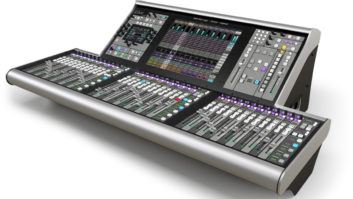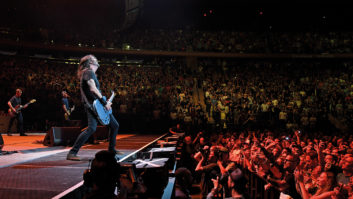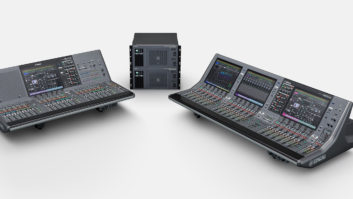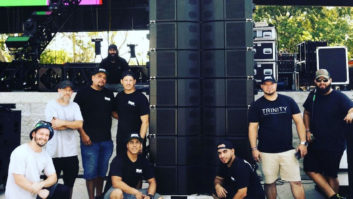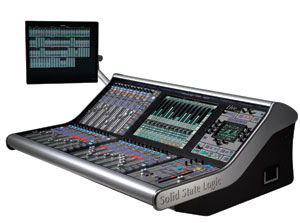
It’s not every day that Solid State Logic introduces a new mixing console, and since the company has never designed one for live sound, I couldn’t wait to get my hands on the SSL Live. The Live console is a natural outgrowth from SSL’s presence in the broadcast industry, where downtime is not an option and the highest audio quality must be maintained. Based upon SSL’s new Tempest digital audio platform, Live is a scalable system supporting 192 simultaneous mix Paths and a staggering 976 physical inputs and outputs. There is local and remote I/O, and the desk can interface via MADI with SSL’s Live Recorder option for recording and playback of up to 64 audio tracks at 96 kHz.
The SSL Live console can be purchased in a standard configuration with 16 balanced XLR mic/line inputs featuring SSL’s SuperAnalogue mic pre, 16 XLR line outputs, and 4 AES3 I/Os with sample rate conversion. The console chassis can be loaded with an additional 16 analog and 4 AES/EBU I/Os, making possible 32×32 analog plus 16×16 digital I/O without need for an outboard interface. A/D and D/A is 24-bit, 96 kHz with 96 kHz/64-bit processing. Two pairs each of redundant optical and MADI coaxial connections (expandable to three pairs) are provided; if redundancy is not required, these ports can run separately for increased channel count. An additional MADI I/O port is designated for effects routing between, for example, a laptop or effects server. Other rear panel connections include word clock, MIDI and LTC I/O, and GPIO, USB and network ports.
The Live system may be expanded with several SSL remote I/Os, including the ML32.32 analog stage box (32×32 analog, onboard A/D/A), and D32.32 AES/EBU stage box (16 AES I/O pairs). Connection between the stage boxes and console is via MADI (co-ax); larger systems can take advantage of SSL’s Blacklight II high-bandwidth transport, which carries up to 256 bidirectional channels over a single fiber connection. When Blacklight II is employed, the BL II.D MADI Concentrator is used to distribute standard MADI co-ax to the stage boxes or to another Live console for monitor mixing (an optional mic split is available). Gain sharing can be implemented whereby one Live desk is designated as the master for preamp gain, and up to three slave consoles automatically apply gain compensation in the digital domain.
U Can Touch This
At the center of the Live control surface is the main video display: a 19-inch high-res touchscreen that provides access to menus, channel and system parameters. This is to our knowledge the only multi-touch screen available on a live desk, facilitating operations such as changing width on a mid-band EQ by pinching the ends of the width lines, which I found very useful.
Surrounding this screen are “Tiles.” Directly below the main screen is a Fader Tile containing 12 channels, each with 100mm motorized faders, Mute, Solo, and Query buttons, and Quick controls for modifying a single parameter for 12 channels (aux send level for example), or a variety of parameters for a single channel dependent upon what is currently onscreen. Alongside each fader are separate meters for level, gate and compression—which made it easy to verify dynamics action without paging through menus. To the right of the faders is a set of Layer Select buttons and a “Screen” button that instantly brings the Tile’s Mixer View to the main screen, virtually extending the channel strips into the touchscreen. Tapping a section of this screen expands that section of a channel.
Pressing a channel’s Query button instantly shows its routing without having to go to a routing menu. Querying a VCA shows its members (nothing new), but you can go the other way as well: Querying a lead vocal channel instantly shows the associated input, aux sends, Stems and VCA assignments (there are 36 VCAs).
An identical Fader Tile occupies the desk’s lower left panel, and a third may be added on the upper left. Fader Tiles organize the Live console’s Paths. A Path is an audio bus such as an input, output, matrix, aux send or Stem (a cross between an aux send and a subgroup). Paths can be configured as mono, stereo or L/C/R. Of the 192 Paths, 144 are considered “full” processing Paths: 4-band parametric EQ, high- and lowpass filter, compressor/limiter, gate/expander, two inserts for internal or external effects, an all-pass filter (see the “Try This” sidebar) and channel delay up to two seconds. The other 48 Paths are “dry,” featuring only the two insert points and a fader, consuming fewer resources than a full Path. These can be used for inputs that do not require processing such as an effects return, click, etc. The processing order of a full or dry Path is completely independent of other Paths and can be changed on-screen in real time. While mixing, I could drag and drop the EQ before or after the compressor without hearing any audible glitches. Very impressive.
Access to channel parameters is augmented with the Channel Control Tile, which has its own touchscreen surrounded by a set of 15 rotary encoders for the selected “Focus” channel. This area provides dedicated hot keys for quick access to EQ, dynamics, aux sends, VCA, and mute groups and insert effects, plus a separate Focus fader. For certain adjustments, such as aux send level, I preferred using this Tile’s knobs because I could leave the main screen parked at the Mixer View.
As you’d expect, the master fader is found in the Master Tile along with 10 Mute Groups, automation, two independent solo buses with three solo output Paths, and two talkback buses. Automation functions include scene store and recall, manual or timecode-based scene triggering, and filters to “safe” parameters that need to remain consistent from scene to scene.
Paths are arranged into layers using the Layer Bank Manager. Each Tile has five layers with five banks per layer. Layers may be set independently for each Tile by simply selecting a layer and then dragging and dropping the channels you want into that layer. Any layer can contain any combination of input channels, VCAs, auxes, Stem groups, masters, matrix outputs, solo outputs and talkback channels. I was able to have layers controlling all of my input channels, but I could also have a star vocal layer that duplicated the lead vocal input alongside its associated VCA, aux sends and effect Stems.
The console architecture employs two independent processing engines—one for audio DSP and the other for control surface functions—so layers may be rearranged while mixing with no audible consequences. SSL’s Eyeconix graphics allow color-coding to simplify channel management with an assortment of images such as kick drum, toms, bass, etc., assignable to channels for fast recognition—and it’s beautiful.
Effects and Monitoring
Separate from the DSP on the full or dry Paths is an effects rack that can process any Path via its insert point. Algorithms include reverb, single- and multi-tap delay, 32-band graphic EQ with 6-, 12- or 18dB range, dynamics (including de-esser, gate and compressor), dynamic EQ, an emulation of the SSL bus compressor (it sounds just like the hardware version), SSL’s VHD Variable Harmonic Drive, and an assortment of modulation effects.
The Effects menu provides access to these effects, which are organized into six racks with up to 16 slots each; a maximum of 96 mono instances are available depending upon the effects in use. Once the Effects page is open, you build a rack by selecting the algorithm, defining the format (mono, stereo, L/C/R, etc.) and inserting the effect into a Path. An inserted effect may be accessed immediately by simply pressing the Insert button in the processing order or channel window, without returning to the effects rack first.
That brings us to the idea of using a Stem Group as an effect return. A Stem Group is a sort of hybrid between an aux send, an audio subgroup and an input. Stem level from a channel may be set to unity as in a subgroup, or varied like an aux send. Once a Stem Path has been created in the System Configuration window, the Stem shows up as a channel parameter. The Stem does not require a separate Path back to the mix bus. When a Stem is used as an effect return, it makes sense to use a dry Path because (a) you probably won’t need filters, EQ and dynamics (and if you do they are probably built into the effect algorithm anyway), and (b) the dry Path sucks up fewer DSP resources. Of course, if you want effects on your effects you can create a Stem using a full Path, or even route one Stem into another.
The Live console’s rear panel has a dedicated video output for a System Monitor Screen that shows an overview of all Paths in use, with metering and clipping indicators, solo and mute status. Because this is in addition to the built-in screens, it is possible to view system status without leaving a menu page—a critical feature for battle conditions.
Other features include Spill, which allows individual faders for a Stereo or L/C/R Path to be controlled using a single fader; complete channel and effects libraries including store, recall, copy and paste functions; a calibrated SPL meter; and built-in FFT. I could go on and on, but what you really want to know is.
How Does It Sound?
Fantastic. After receiving a brief tutorial from the kind folks at SSL, I was off and running quickly. VCA and mute group assignments are easily accessible. You can edit channels quickly by selecting the channel and using the Channel Control Tile to alter the parameters of each section. Onboard processing is first-rate, and Tempest’s processing muscle allows you to do things like sweep an EQ without ever hearing zipper noise, or re-order the channel processing blocks without glitches. Reverbs and delays were lush, and it was a luxury to have multiple instances of the SSL bus compressor onboard.
The EQ section has the SSL sound you expect and is equally effective for fine and broad strokes. The ability to use the touchscreen to adjust parameters was especially nice for things like changing the knee on a compressor or simultaneously sweeping frequency and adjusting gain on an EQ band using one finger. SSL’s engineers have managed to furnish a ton of information on the desk without making it feel like you are being overloaded with data. I drive a lot of Chryslers. It was nice to get behind the wheel of a Ferrari for a little while.
Steve LaCerra is a New York-based live sound and recording engineer.
TRY THIS
Unique to the SSL Live is the all-pass filter built into every full processing path. An all-pass filter has a linear frequency response but varies phase as a function of frequency. This filter may be used for functions such as adjusting phase between two mics on a single source or for eliminating feedback on a wedge mix. To use the all-pass filter to eliminate feedback, select the channel and tap on the all-pass filter in the processor order graphic. You’ll see a display of phase versus frequency. Pinch the bands so that a narrow width is achieved, then sweep the band to the offending frequency. The phase at that frequency will be inverted, killing the feedback.
Product Summary
COMPANY: Solid Stage Logic
PRODUCT: Live
WEBSITE:www.solidstatelogic.com
PRICE: Based upon configuration
PROS: Scalable system, outstanding sound quality and versatility, built-in redundancy.
CONS: Does not support third-party software plug-ins.


